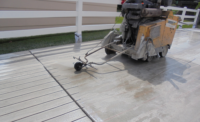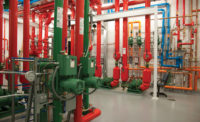Since corrugated stainless-steel tubing entered the U.S. market, it’s been utilized in some interesting projects. There’s CSST gap piping installed in single-family homes across the country and in huge sports complexes. CSST is used in areas prone to seismic activity and where lightning strikes are common.
Let’s test this thing
One project where CSST played a role was constructed in 2012 by structural engineers at the University of California-San Diego’s Englekirk Structural Engineering Center. The $5 million project was supported by the National Science Foundation and a large number of industry partners.
The idea? Test how various structural components of vital structures such as hospitals would handle the shake, rattle and roll of an earthquake.
“After the 1994 Northridge earthquake in Southern California there were at least 50 reported gas-related fires above ground where rigid pipe had been the predominant gas piping material for decades,” says Rob Haines, business development manager for OmegaFlex. “Basically they built a [full-scale model] of a five-story hospital.”
The 14 million-pound structure was built at full-scale and completely furnished including a functioning passenger elevator, partition walls, cladding and glazing systems, piping, HVAC, ceiling, sprinklers, building contents, as well as passive and active fire systems.
“We had an outside mechanical contractor come in and run five stories of TracPipe, and alongside it, had the same contractor run five stories of black pipe,” Haines adds. “Then, they put the structure on a shaker plate and ran it to duplicate the Denali earthquake in Alaska for the same amount of time. The black pipe broke in several places and the CSST held pressure during the entire test.”
Speaking of seismic activity
CSST has its origins in Japan, where there is a great deal of earthquake activity.
“When they went back after the Kobe earthquake and looked at all the new buildings that were using CSST is when they realized most of the piping systems that had been destroyed were rigid pipe systems,” Haines says. “In the ensuing years, Japan has gone to almost all flexible piping for gas piping.
“Over the past 20-plus years more than 900 million ft. of CSST has been made and installed in the United States. California has historically been one of the largest CSST markets. Since CSST came into the industry, it’s been widely used throughout both residential and commercial from San Diego up to the Oregon border. Even though it’s been widely used in the San Francisco Bay Area, it was not used in San Francisco until a few years ago.”
One of the first ventures into this area was multi-family housing, the 198-unit Candlestick Heights project, a complex of one-to-four-bedroom apartments in San Francisco. Bay Area-based Broadway Mechanical-Contractors chose to install OmegaFlex TracPipe CounterStrike, Haines says.
“Broadway Mechanical had been looking for the right application for our product for a long time. They decided it was the perfect-size project and the perfect location to highlight the product’s seismic capabilities.”
An estimated 10,000 ft. of CSST was used in the project.
“If you’re going from the meter in the basement up all the way across the garage roof and up to a unit — let’s say that might be 130 ft. — there’s no leak paths, just a fitting on each end,” Haines says. “Whereas with 130 ft. of black pipe, you would have a coupling every 22 ft., meaning five or six more possible leak paths just in that one run. Multiply that by 198 units and it’s a huge difference.
“You don’t have to cut steel pipe; you don’t have to get out a threader and thread it; you don’t have to cut for elbows and tees. You don’t have to put any elbows in; you don’t have to put any tees in, almost always end fittings. CSST is semi-rigid. You have all these corrugations along the entire length of the tubing; if you were to take a 4-ft.-long piece in your hand; it’ll stay straight. But if you bend it, it’ll bend into a 90° angle and stay that way.”
Some really big projects
“One of biggest important products right now as it relates to seismic is our Seismic DoubleTrac. For example, DoubleTrac is for liquid fuel, where you have to have a double containment pipe, running fuel to a backup generator in a hospital,” Haines says.
“This large commercial/institutional niche includes large data centers that can’t afford to go down. They have large backup generators that must be reliably provided with fuel. Large military facilities, hotels and casinos may have some of the same requirements. It’s also used for underground runs in retail gas stations and widely used by governments for dock and pier installations for filling gasoline and diesel fuel on ships.”
This article was originally titled “Where it is needed most” in the February 2016 print edition of PM Engineer.




